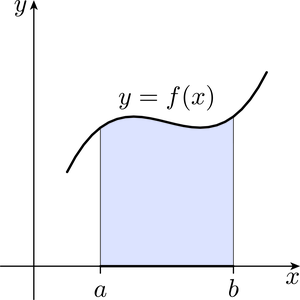1.1 Areas under curves
One of the uses of real integration is to determine the area under a curve. For example, the integral of a continuous function that takes only positive values between the real numbers and , where , is the area bounded by the graph of , the -axis, and the two vertical lines and , as illustrated by the shaded part of Figure 5.
We can estimate this area by first splitting the interval into a finite number of subintervals, such as those shown in Figure 6.
We can then underestimate the area under the graph of between and by summing the areas of those rectangles that have the various subintervals as bases and for which the top edge of each rectangle touches the graph from below, as shown in Figure 7(a). Similarly, we can overestimate the area under between and by summing the areas of those rectangles that have the various subintervals as bases and for which the top edge of each rectangle touches the graph from above, as shown in Figure 7(b).
We now let the number of subintervals tend to infinity, in such a way that the lengths of the subintervals tend to zero. It can be shown that the underestimates and overestimates of the area tend to a common limit , written as
We call the area under the graph of between and .
This underestimating and overestimating approach is often how Riemann integration is first introduced, and you may have seen it before. However, we encounter a problem if we try to generalise this particular approach to complex functions. Inequalities between complex numbers have no meaning, so it makes no sense to try to estimate complex numbers from ‘below’ or ‘above’. To get round this problem, we now outline a different approach to defining the integral of a real function – one that does generalise to complex functions.
Rather than underestimating and overestimating the area under the curve with rectangles, we choose a single point inside each subinterval and use this to construct a rectangle whose base is the subinterval, and whose height is the value of the function at the chosen point. The sum of the areas of these rectangles should then be an approximation to the area under the graph. As long as our function is continuous on the interval , then this modified approach (which does generalise to complex integrals) agrees with the underestimating and overestimating approach.
In this section we use this modified approach to give a formal definition of the Riemann integral, and then we summarise the main properties of the Riemann integral. We omit all proofs, which can be found in texts on real analysis.


